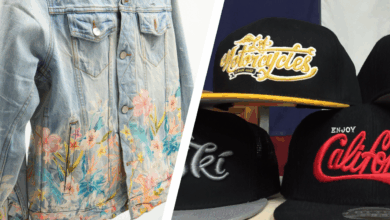Keep these fundamental rules in mind when mixing different heat transfer products.
- Always ensure that the transfer requiring the highest heat for the longest time at the firmest pressure receives it. For instance, when combining a product that applies at 300 degrees F and 330 degrees F, ere on the side of 330 degrees. Reaching the melting point of the adhesive is critical for the durability of the garment when laundered.
- Use a cover sheet. When mixing and matching materials, like sequin materials and heat transfer film, use a Kraft Paper cover sheet or similar paper to avoid any issues with a previously applied material sticking to the upper platen after application.
- Watch out for “carrier marks.” Often, another material’s carrier sheet can impact a heat transfer material if it is applied for too long. If possible, try to trim the carrier of the top transfer in a way that it doesn’t have contact with other parts of the design, or test apply a sample utilizing a shortened application, such as 2-3 seconds to remove the carrier before completing the entire design with a cover sheet for the full setting.
- Ensure layering compatibility. If planning to overlap materials, be sure that they are compatible. Some manufacturers of heat transfers can guide you towards material combination settings. But if you’re creating something out of the box, some independent wash testing may be warranted.
For more on mixed media heat transfer designs, check out the Ellsworths’ full-length article here.
—Stahls’



